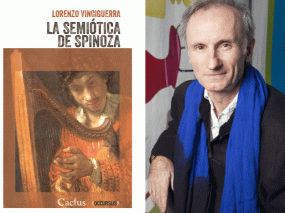News

Publication of La semiótica de Spinoza at Editorial Cactus (Argentina) by Lorenzo Vinciguerra, University Picardie Jules Vernes and 2019-2020 IAS-Nantes fellow.
To what extent does imagination produce our emotional life? Lorenzo Vinciguerra here takes up again a meditation that has been central to philosophy since the 17th century, the relationship between our capacity to form images, thoughts and the body. Far from being a "minor" faculty of the soul, condemned exclusively to error and raving, the imagination organizes a series of questions around the thought of the body, questions that not only succeed in remedying the indifference of the history of semiotics towards Spinoza, but also vitalize new artistic reflections. After the study of the notion of vestigium (trace), the corporeal genealogy of the imagination is verified and its notable incidence on cognitive processes is illuminated: understood as knowledge "by signs", the imagination projects the material possibility of an autonomous state of well-being. Art, thus, testifies to a virtuous relationship between mind and body where its power is expressed as the possibility of tracing and being traced. For this research, Vinciguerra proposes to re-read Spinoza’s work from an original perspective: a genetic analysis of the image and the sign through his texts, in parallel and in a fruitful dialogue with C. S. Peirce’s thesis. Is it not significant in itself that Spinoza has chosen the practice of language and writing to illustrate his conception of the identity of the living body? It is the problems of the plastic nature of the world that in turn intervene in the configuration of the historical body, identity and memory.
(Description from Editorial Cactus)
More information here.

